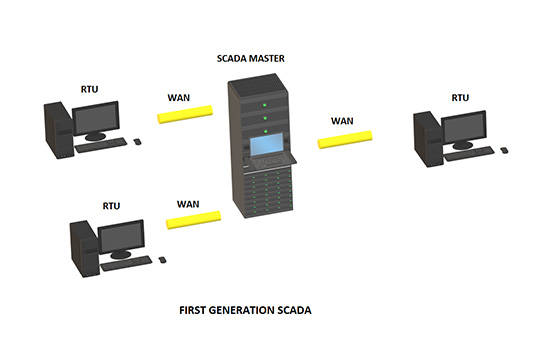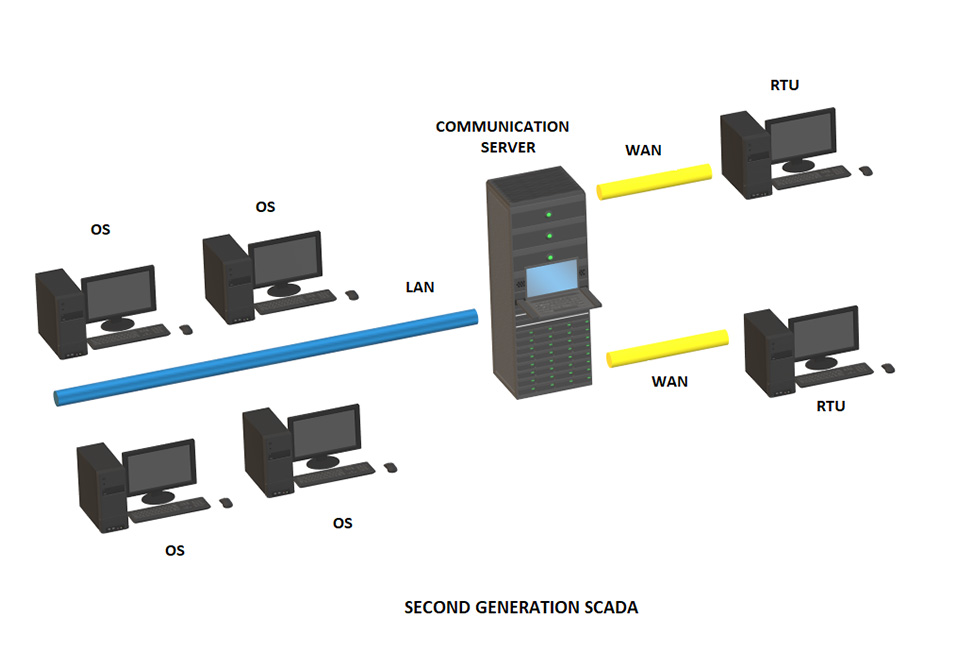- Room for insight!
- (02) 860 88 960
- info@controlhub.com.au
SCADA architecture, legacy to modern structure

Robotic vision system VS. computer vision system
19 May 2022
Reasons to use variable speed drives
23 June 2022SCADA architecture, legacy to modern structure
Early stage to cloud base SCADA Systems
The following sections describe three generations of SCADA systems:
- Monolithic
- Distributed
- Networked SCADA systems (Cloud base)
Monolithic SCADA systems
Within the development of SCADA systems, the idea of computing has generally focused on "mainframe" structures. Networks were commonly non-existent, and each centralised system stood on its own. SCADA systems had been therefore standalone systems that had virtually no connection to other systems.
The wide area networks (WANs) implemented to communicate with remote control terminals (RTUs) were designed with a single purpose - to communicate with RTUs in the field and nothing more. additionally, the WAN protocols used today were largely unknown at the time.
The communication protocols used in SCADA networks have been developed via RTU equipment vendors and have been often proprietary.
Furthermore, those protocols were commonly very "thin" supporting virtually no further functionality, requiring scanning and controlling points within the remote device. It was also usually not possible to mix other types of traffic with RTU communications on the network.
Redundancy in these first-generation systems was accomplished using two identically equipped mainframe systems, one primary and one backup, connected at the bus level.
The principal function of the standby system was to monitor the primary database and take over in case of a detected failure. This kind of standby mode meant that little or no processing was performed on the standby system.
Distributed SCADA systems
The next generation of SCADA systems took advantage of developments and improvements in system miniaturisation and local area Networking (LAN) technology to distribute processing across multiple systems. Multiple stations, each with a specific function, were linked to a LAN in real-time and information become shared.
These stations were typical of the mini-computer class, smaller and much less expensive than their first-generation processors.
Some of these distributed stations served as communications processors, communicating mainly with field devices such as RTUs. Some served as operator interfaces to provide human-machine interfaces (HMI) for network operators. still, others served as computation processors or database servers.
Distributing the individual SCADA system functions across multiple systems provides more computing power to the system as an entire than would were available in a single processor.
The networks connecting those individual systems were generally based totally on LAN protocols and could not cross the boundaries of the local environment.
Some of the LAN protocols used were of a proprietary nature, where the vendor created their own network protocol or version instead of pulling an existing protocol off the shelf. This allowed a provider to optimize their LAN protocol for real-time traffic. However, the connection of third-party networks to the SCADA LAN has been restricted (or efficaciously eliminated)
The distribution of the system functionality to networked structures not only served to increase the computing power however also to increase the computing power to improve the redundancy and reliability of the system as an entire. Rather than the simple primary/standby failover scheme used in many first-generation systems, the distributed architecture always kept all stations on the LAN online.
For instance, if one HMI station fails, another HMI station could be used to run the system without waiting for failover from the primary system to the secondary system.
The WAN used to communicate with devices in the field was largely unchanged by the development of LAN connectivity between local stations at the SCADA master. These external communication networks were still limited to RTU protocols and have been unavailable for other types of network traffic.
As with the first generation of systems, the second generation of SCADA systems was also restricted to hardware, software, and peripherals that were provided or at least selected by the supplier.
Networked SCADA systems (Cloud base)
The current generation of SCADA master station architecture is closely associated with the second generation. The principal difference is an open system architecture and not a manufacturer-controlled, proprietary environment.
There are still multiple networked systems that share master station functions. There are still RTUs using protocols which can be proprietary.
The major improvement in the third generation is that of opening the system architecture, using open standards and protocols, and spreading SCADA functions over a WAN and not just a LAN.
Open standards remove several limitations of previous generations of SCADA systems. The use of standard systems makes it simpler for the user to connect third-party peripherals (e.g., monitors, printers, hard drives, tape drives, and so on.) to the system and/or network.
As they have moved to “open” or “off the shelf” systems, SCADA companies have gradually stepped out of the hardware development business. These vendors have looked to systems vendors such as Compaq, Hewlett Packard, and sun Microsystems for their expertise in developing the fundamental computing platforms and operating system software.
This allows SCADA vendors to focus their development on an area where they can add specific value to the system over the SCADA master Station software.
The primary improvement in third-generation SCADA systems is based on the use of WAN protocols such as internet Protocol (IP) for communication between the central office and communication equipment. This allows a part of the master station that is accountable for communication with the field devices to be separated from the master station "properly" via a WAN.
Vendors are producing RTUs which can communicate with the master station over an Ethernet connection.
Some other advantage of distributing SCADA functionality across a WAN is that of disaster survivability. Distributing SCADA processing over a LAN in second-generation systems improves reliability but, in the event of a catastrophic failure of the facility hosting the SCADA master, the entire system could also be lost.
Distributing the processing to physically separated locations makes it possible to build a SCADA system which could survive a total loss of any of the locations.
For some companies that view SCADA as a supercritical function, that is a real advantage.





